Business and Business Environment: Macro Environment Impact on Retail
VerifiedAdded on 2020/10/23
|14
|4349
|471
Report
AI Summary
This report provides a comprehensive analysis of the UK business environment, focusing on the retail sector. It begins by differentiating between profit, non-profit, and non-governmental organizations, exploring their structures, purposes, and operational scopes. The report then delves into the distinctions between micro, small, medium, and large enterprises, examining their market share, profit share, growth, and sustainability. Furthermore, it outlines various organizational structures, including line, line-staff, and matrix structures, and discusses the complexities of transnational, international, and global business operations. The report concludes with a case study analyzing the positive and negative impacts of the macro environment on the UK retail sector and internal and external analysis of UK supermarkets to identify their strengths, weaknesses and how they interrelate with the external macro factors.
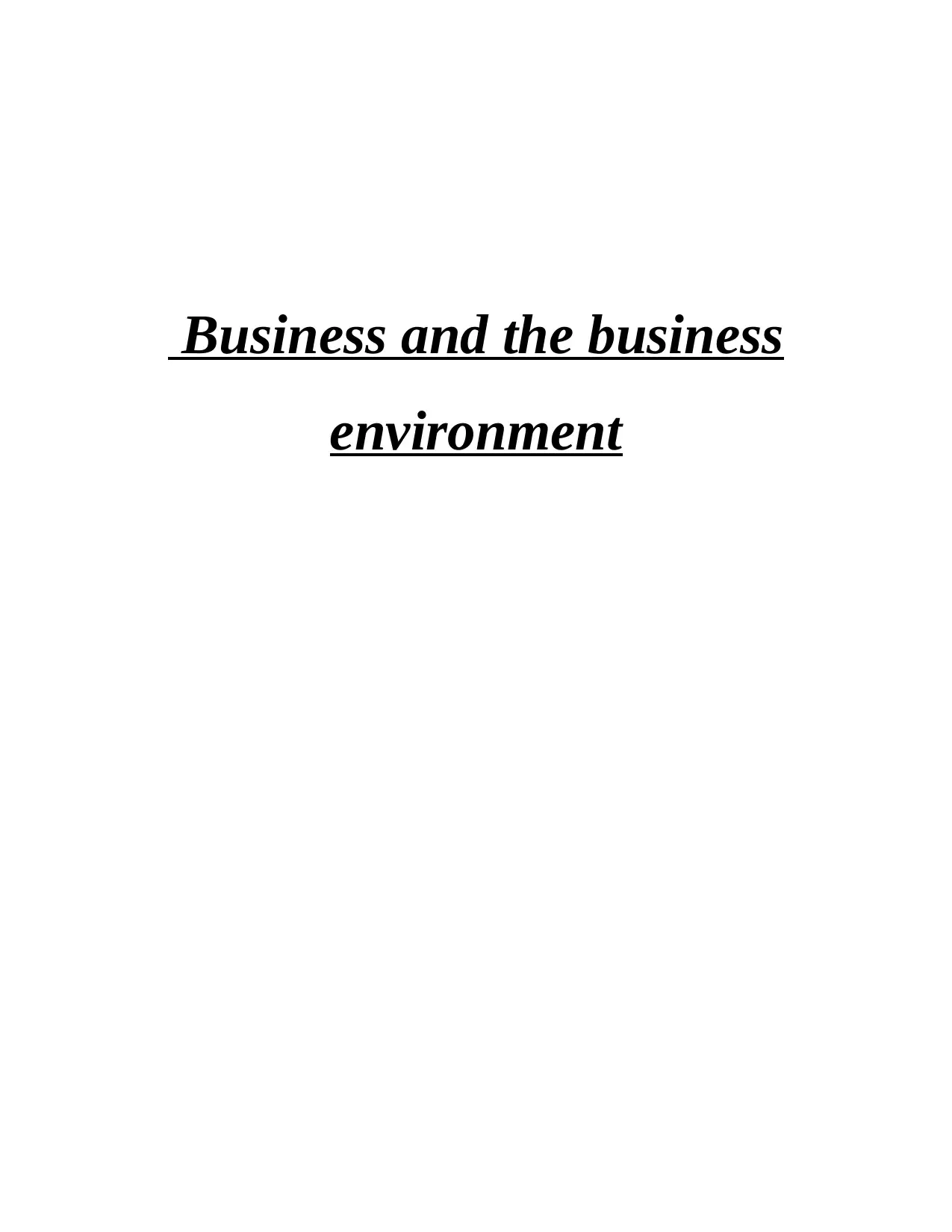
Business and the business
environment
environment
Paraphrase This Document
Need a fresh take? Get an instant paraphrase of this document with our AI Paraphraser
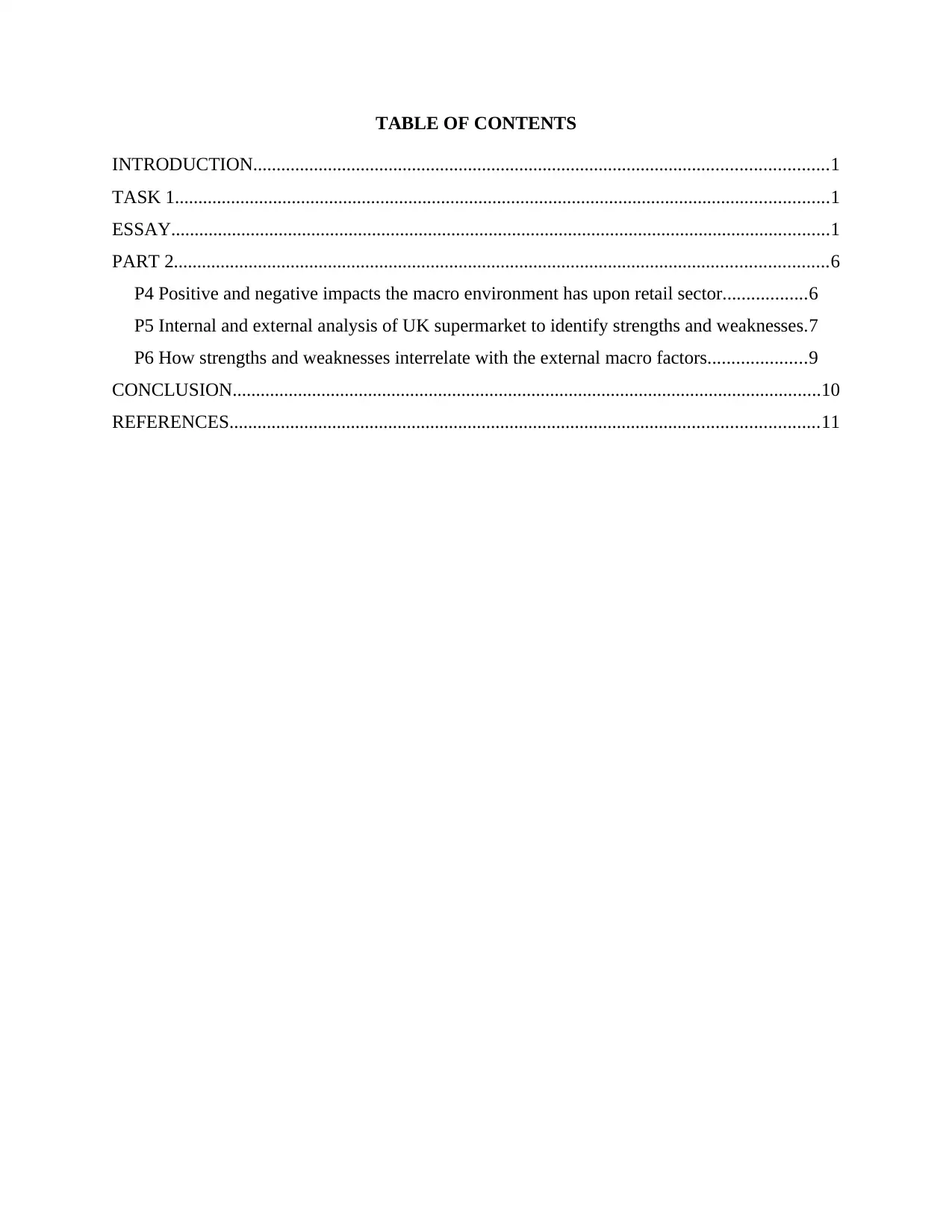
TABLE OF CONTENTS
INTRODUCTION...........................................................................................................................1
TASK 1............................................................................................................................................1
ESSAY.............................................................................................................................................1
PART 2............................................................................................................................................6
P4 Positive and negative impacts the macro environment has upon retail sector..................6
P5 Internal and external analysis of UK supermarket to identify strengths and weaknesses.7
P6 How strengths and weaknesses interrelate with the external macro factors.....................9
CONCLUSION..............................................................................................................................10
REFERENCES..............................................................................................................................11
INTRODUCTION...........................................................................................................................1
TASK 1............................................................................................................................................1
ESSAY.............................................................................................................................................1
PART 2............................................................................................................................................6
P4 Positive and negative impacts the macro environment has upon retail sector..................6
P5 Internal and external analysis of UK supermarket to identify strengths and weaknesses.7
P6 How strengths and weaknesses interrelate with the external macro factors.....................9
CONCLUSION..............................................................................................................................10
REFERENCES..............................................................................................................................11
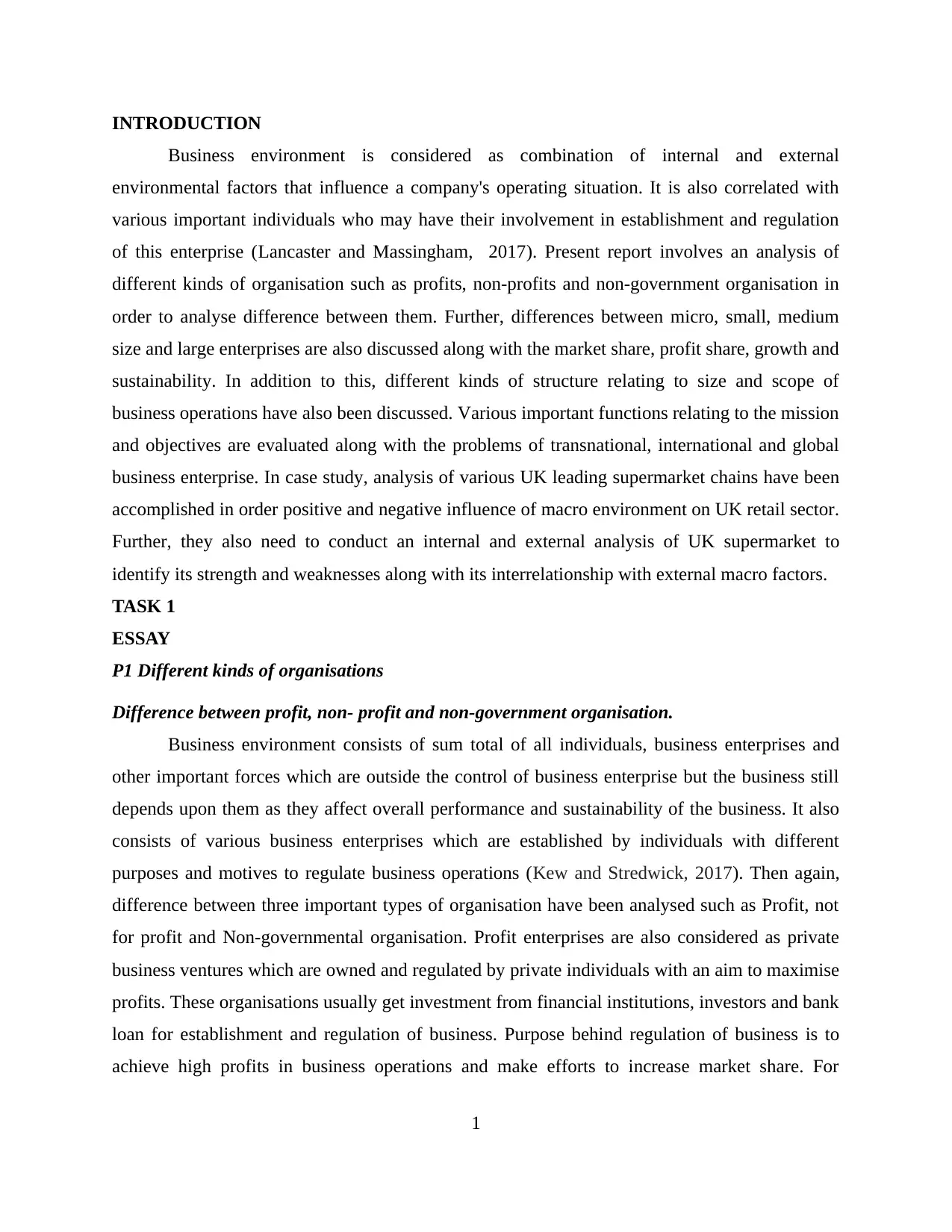
INTRODUCTION
Business environment is considered as combination of internal and external
environmental factors that influence a company's operating situation. It is also correlated with
various important individuals who may have their involvement in establishment and regulation
of this enterprise (Lancaster and Massingham, 2017). Present report involves an analysis of
different kinds of organisation such as profits, non-profits and non-government organisation in
order to analyse difference between them. Further, differences between micro, small, medium
size and large enterprises are also discussed along with the market share, profit share, growth and
sustainability. In addition to this, different kinds of structure relating to size and scope of
business operations have also been discussed. Various important functions relating to the mission
and objectives are evaluated along with the problems of transnational, international and global
business enterprise. In case study, analysis of various UK leading supermarket chains have been
accomplished in order positive and negative influence of macro environment on UK retail sector.
Further, they also need to conduct an internal and external analysis of UK supermarket to
identify its strength and weaknesses along with its interrelationship with external macro factors.
TASK 1
ESSAY
P1 Different kinds of organisations
Difference between profit, non- profit and non-government organisation.
Business environment consists of sum total of all individuals, business enterprises and
other important forces which are outside the control of business enterprise but the business still
depends upon them as they affect overall performance and sustainability of the business. It also
consists of various business enterprises which are established by individuals with different
purposes and motives to regulate business operations (Kew and Stredwick, 2017). Then again,
difference between three important types of organisation have been analysed such as Profit, not
for profit and Non-governmental organisation. Profit enterprises are also considered as private
business ventures which are owned and regulated by private individuals with an aim to maximise
profits. These organisations usually get investment from financial institutions, investors and bank
loan for establishment and regulation of business. Purpose behind regulation of business is to
achieve high profits in business operations and make efforts to increase market share. For
1
Business environment is considered as combination of internal and external
environmental factors that influence a company's operating situation. It is also correlated with
various important individuals who may have their involvement in establishment and regulation
of this enterprise (Lancaster and Massingham, 2017). Present report involves an analysis of
different kinds of organisation such as profits, non-profits and non-government organisation in
order to analyse difference between them. Further, differences between micro, small, medium
size and large enterprises are also discussed along with the market share, profit share, growth and
sustainability. In addition to this, different kinds of structure relating to size and scope of
business operations have also been discussed. Various important functions relating to the mission
and objectives are evaluated along with the problems of transnational, international and global
business enterprise. In case study, analysis of various UK leading supermarket chains have been
accomplished in order positive and negative influence of macro environment on UK retail sector.
Further, they also need to conduct an internal and external analysis of UK supermarket to
identify its strength and weaknesses along with its interrelationship with external macro factors.
TASK 1
ESSAY
P1 Different kinds of organisations
Difference between profit, non- profit and non-government organisation.
Business environment consists of sum total of all individuals, business enterprises and
other important forces which are outside the control of business enterprise but the business still
depends upon them as they affect overall performance and sustainability of the business. It also
consists of various business enterprises which are established by individuals with different
purposes and motives to regulate business operations (Kew and Stredwick, 2017). Then again,
difference between three important types of organisation have been analysed such as Profit, not
for profit and Non-governmental organisation. Profit enterprises are also considered as private
business ventures which are owned and regulated by private individuals with an aim to maximise
profits. These organisations usually get investment from financial institutions, investors and bank
loan for establishment and regulation of business. Purpose behind regulation of business is to
achieve high profits in business operations and make efforts to increase market share. For
1
⊘ This is a preview!⊘
Do you want full access?
Subscribe today to unlock all pages.

Trusted by 1+ million students worldwide
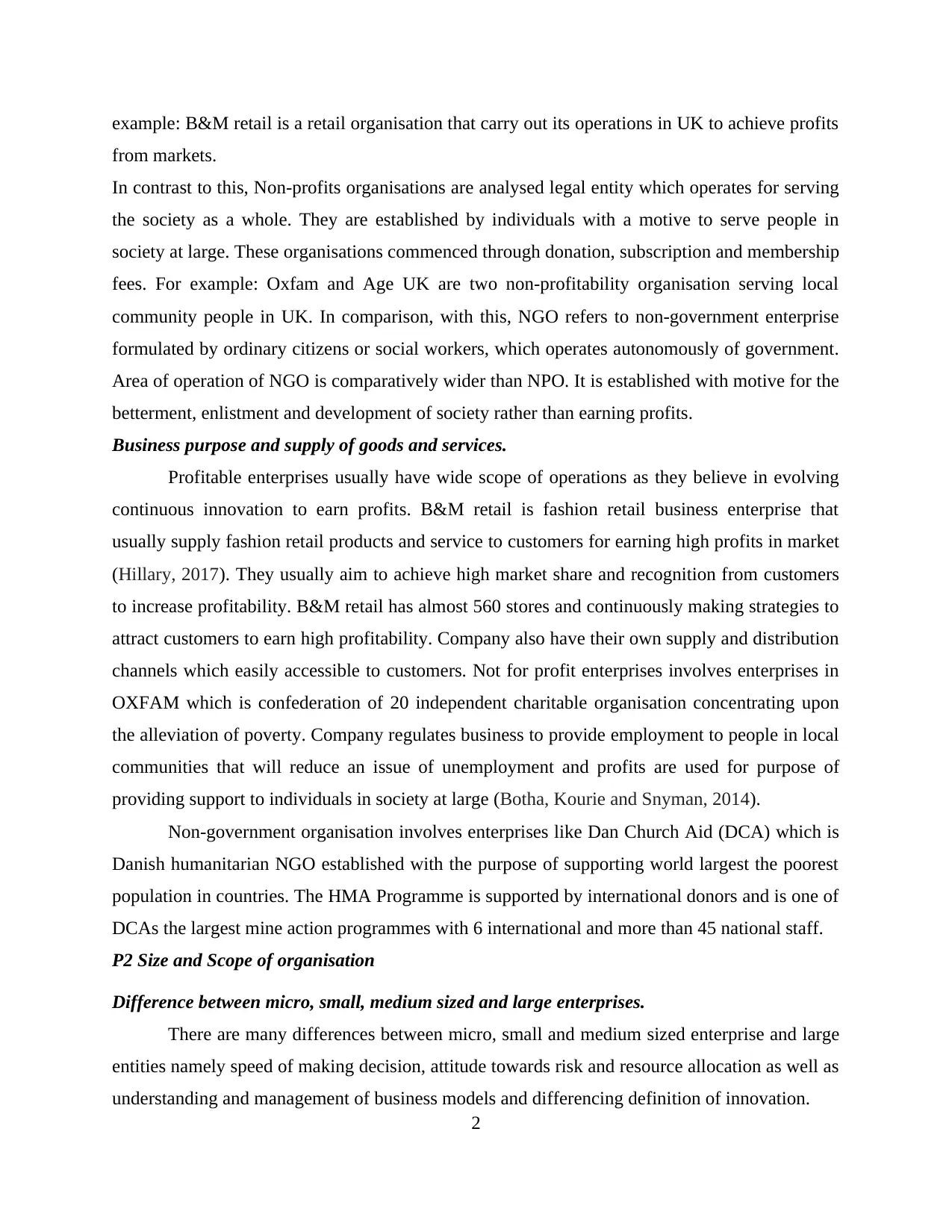
example: B&M retail is a retail organisation that carry out its operations in UK to achieve profits
from markets.
In contrast to this, Non-profits organisations are analysed legal entity which operates for serving
the society as a whole. They are established by individuals with a motive to serve people in
society at large. These organisations commenced through donation, subscription and membership
fees. For example: Oxfam and Age UK are two non-profitability organisation serving local
community people in UK. In comparison, with this, NGO refers to non-government enterprise
formulated by ordinary citizens or social workers, which operates autonomously of government.
Area of operation of NGO is comparatively wider than NPO. It is established with motive for the
betterment, enlistment and development of society rather than earning profits.
Business purpose and supply of goods and services.
Profitable enterprises usually have wide scope of operations as they believe in evolving
continuous innovation to earn profits. B&M retail is fashion retail business enterprise that
usually supply fashion retail products and service to customers for earning high profits in market
(Hillary, 2017). They usually aim to achieve high market share and recognition from customers
to increase profitability. B&M retail has almost 560 stores and continuously making strategies to
attract customers to earn high profitability. Company also have their own supply and distribution
channels which easily accessible to customers. Not for profit enterprises involves enterprises in
OXFAM which is confederation of 20 independent charitable organisation concentrating upon
the alleviation of poverty. Company regulates business to provide employment to people in local
communities that will reduce an issue of unemployment and profits are used for purpose of
providing support to individuals in society at large (Botha, Kourie and Snyman, 2014).
Non-government organisation involves enterprises like Dan Church Aid (DCA) which is
Danish humanitarian NGO established with the purpose of supporting world largest the poorest
population in countries. The HMA Programme is supported by international donors and is one of
DCAs the largest mine action programmes with 6 international and more than 45 national staff.
P2 Size and Scope of organisation
Difference between micro, small, medium sized and large enterprises.
There are many differences between micro, small and medium sized enterprise and large
entities namely speed of making decision, attitude towards risk and resource allocation as well as
understanding and management of business models and differencing definition of innovation.
2
from markets.
In contrast to this, Non-profits organisations are analysed legal entity which operates for serving
the society as a whole. They are established by individuals with a motive to serve people in
society at large. These organisations commenced through donation, subscription and membership
fees. For example: Oxfam and Age UK are two non-profitability organisation serving local
community people in UK. In comparison, with this, NGO refers to non-government enterprise
formulated by ordinary citizens or social workers, which operates autonomously of government.
Area of operation of NGO is comparatively wider than NPO. It is established with motive for the
betterment, enlistment and development of society rather than earning profits.
Business purpose and supply of goods and services.
Profitable enterprises usually have wide scope of operations as they believe in evolving
continuous innovation to earn profits. B&M retail is fashion retail business enterprise that
usually supply fashion retail products and service to customers for earning high profits in market
(Hillary, 2017). They usually aim to achieve high market share and recognition from customers
to increase profitability. B&M retail has almost 560 stores and continuously making strategies to
attract customers to earn high profitability. Company also have their own supply and distribution
channels which easily accessible to customers. Not for profit enterprises involves enterprises in
OXFAM which is confederation of 20 independent charitable organisation concentrating upon
the alleviation of poverty. Company regulates business to provide employment to people in local
communities that will reduce an issue of unemployment and profits are used for purpose of
providing support to individuals in society at large (Botha, Kourie and Snyman, 2014).
Non-government organisation involves enterprises like Dan Church Aid (DCA) which is
Danish humanitarian NGO established with the purpose of supporting world largest the poorest
population in countries. The HMA Programme is supported by international donors and is one of
DCAs the largest mine action programmes with 6 international and more than 45 national staff.
P2 Size and Scope of organisation
Difference between micro, small, medium sized and large enterprises.
There are many differences between micro, small and medium sized enterprise and large
entities namely speed of making decision, attitude towards risk and resource allocation as well as
understanding and management of business models and differencing definition of innovation.
2
Paraphrase This Document
Need a fresh take? Get an instant paraphrase of this document with our AI Paraphraser
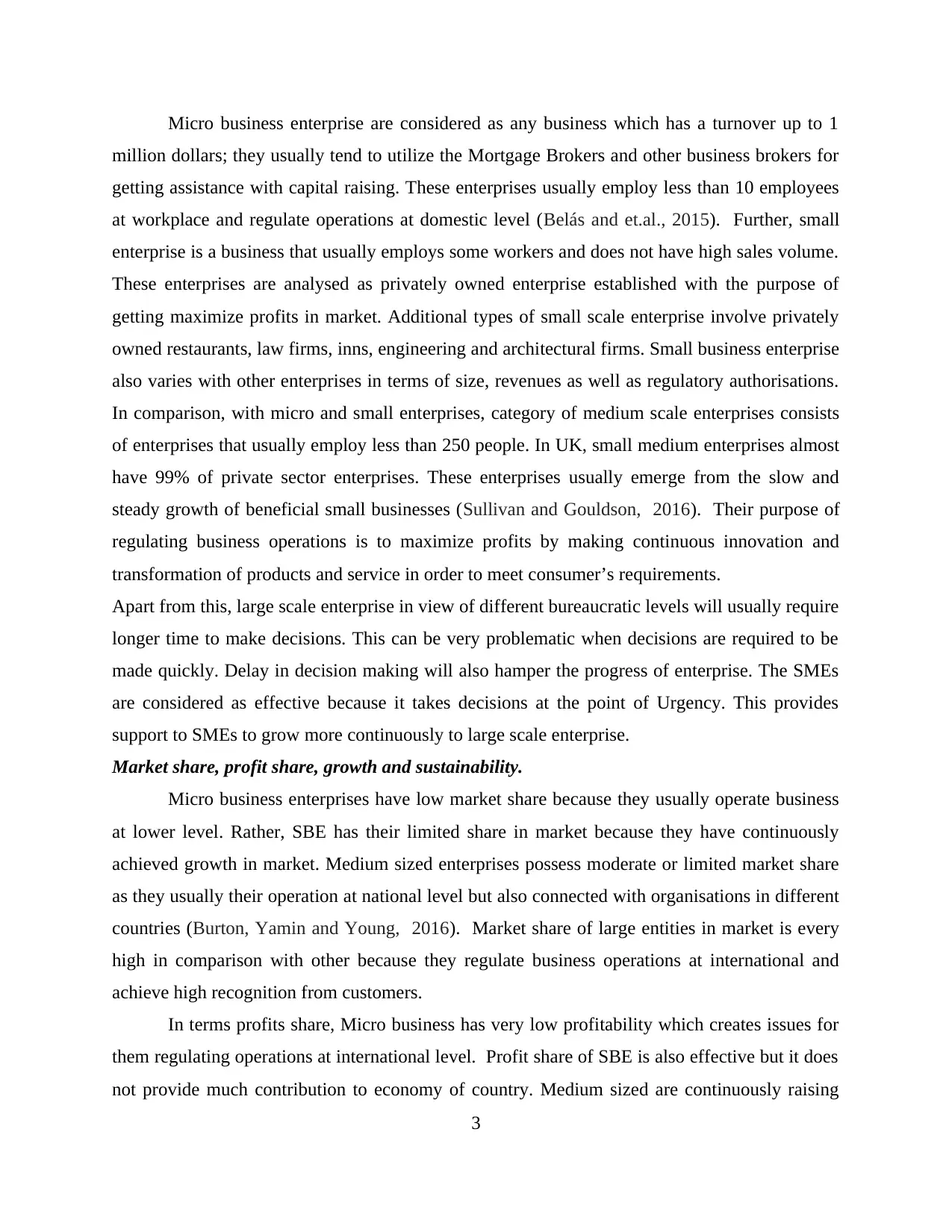
Micro business enterprise are considered as any business which has a turnover up to 1
million dollars; they usually tend to utilize the Mortgage Brokers and other business brokers for
getting assistance with capital raising. These enterprises usually employ less than 10 employees
at workplace and regulate operations at domestic level (Belás and et.al., 2015). Further, small
enterprise is a business that usually employs some workers and does not have high sales volume.
These enterprises are analysed as privately owned enterprise established with the purpose of
getting maximize profits in market. Additional types of small scale enterprise involve privately
owned restaurants, law firms, inns, engineering and architectural firms. Small business enterprise
also varies with other enterprises in terms of size, revenues as well as regulatory authorisations.
In comparison, with micro and small enterprises, category of medium scale enterprises consists
of enterprises that usually employ less than 250 people. In UK, small medium enterprises almost
have 99% of private sector enterprises. These enterprises usually emerge from the slow and
steady growth of beneficial small businesses (Sullivan and Gouldson, 2016). Their purpose of
regulating business operations is to maximize profits by making continuous innovation and
transformation of products and service in order to meet consumer’s requirements.
Apart from this, large scale enterprise in view of different bureaucratic levels will usually require
longer time to make decisions. This can be very problematic when decisions are required to be
made quickly. Delay in decision making will also hamper the progress of enterprise. The SMEs
are considered as effective because it takes decisions at the point of Urgency. This provides
support to SMEs to grow more continuously to large scale enterprise.
Market share, profit share, growth and sustainability.
Micro business enterprises have low market share because they usually operate business
at lower level. Rather, SBE has their limited share in market because they have continuously
achieved growth in market. Medium sized enterprises possess moderate or limited market share
as they usually their operation at national level but also connected with organisations in different
countries (Burton, Yamin and Young, 2016). Market share of large entities in market is every
high in comparison with other because they regulate business operations at international and
achieve high recognition from customers.
In terms profits share, Micro business has very low profitability which creates issues for
them regulating operations at international level. Profit share of SBE is also effective but it does
not provide much contribution to economy of country. Medium sized are continuously raising
3
million dollars; they usually tend to utilize the Mortgage Brokers and other business brokers for
getting assistance with capital raising. These enterprises usually employ less than 10 employees
at workplace and regulate operations at domestic level (Belás and et.al., 2015). Further, small
enterprise is a business that usually employs some workers and does not have high sales volume.
These enterprises are analysed as privately owned enterprise established with the purpose of
getting maximize profits in market. Additional types of small scale enterprise involve privately
owned restaurants, law firms, inns, engineering and architectural firms. Small business enterprise
also varies with other enterprises in terms of size, revenues as well as regulatory authorisations.
In comparison, with micro and small enterprises, category of medium scale enterprises consists
of enterprises that usually employ less than 250 people. In UK, small medium enterprises almost
have 99% of private sector enterprises. These enterprises usually emerge from the slow and
steady growth of beneficial small businesses (Sullivan and Gouldson, 2016). Their purpose of
regulating business operations is to maximize profits by making continuous innovation and
transformation of products and service in order to meet consumer’s requirements.
Apart from this, large scale enterprise in view of different bureaucratic levels will usually require
longer time to make decisions. This can be very problematic when decisions are required to be
made quickly. Delay in decision making will also hamper the progress of enterprise. The SMEs
are considered as effective because it takes decisions at the point of Urgency. This provides
support to SMEs to grow more continuously to large scale enterprise.
Market share, profit share, growth and sustainability.
Micro business enterprises have low market share because they usually operate business
at lower level. Rather, SBE has their limited share in market because they have continuously
achieved growth in market. Medium sized enterprises possess moderate or limited market share
as they usually their operation at national level but also connected with organisations in different
countries (Burton, Yamin and Young, 2016). Market share of large entities in market is every
high in comparison with other because they regulate business operations at international and
achieve high recognition from customers.
In terms profits share, Micro business has very low profitability which creates issues for
them regulating operations at international level. Profit share of SBE is also effective but it does
not provide much contribution to economy of country. Medium sized are continuously raising
3
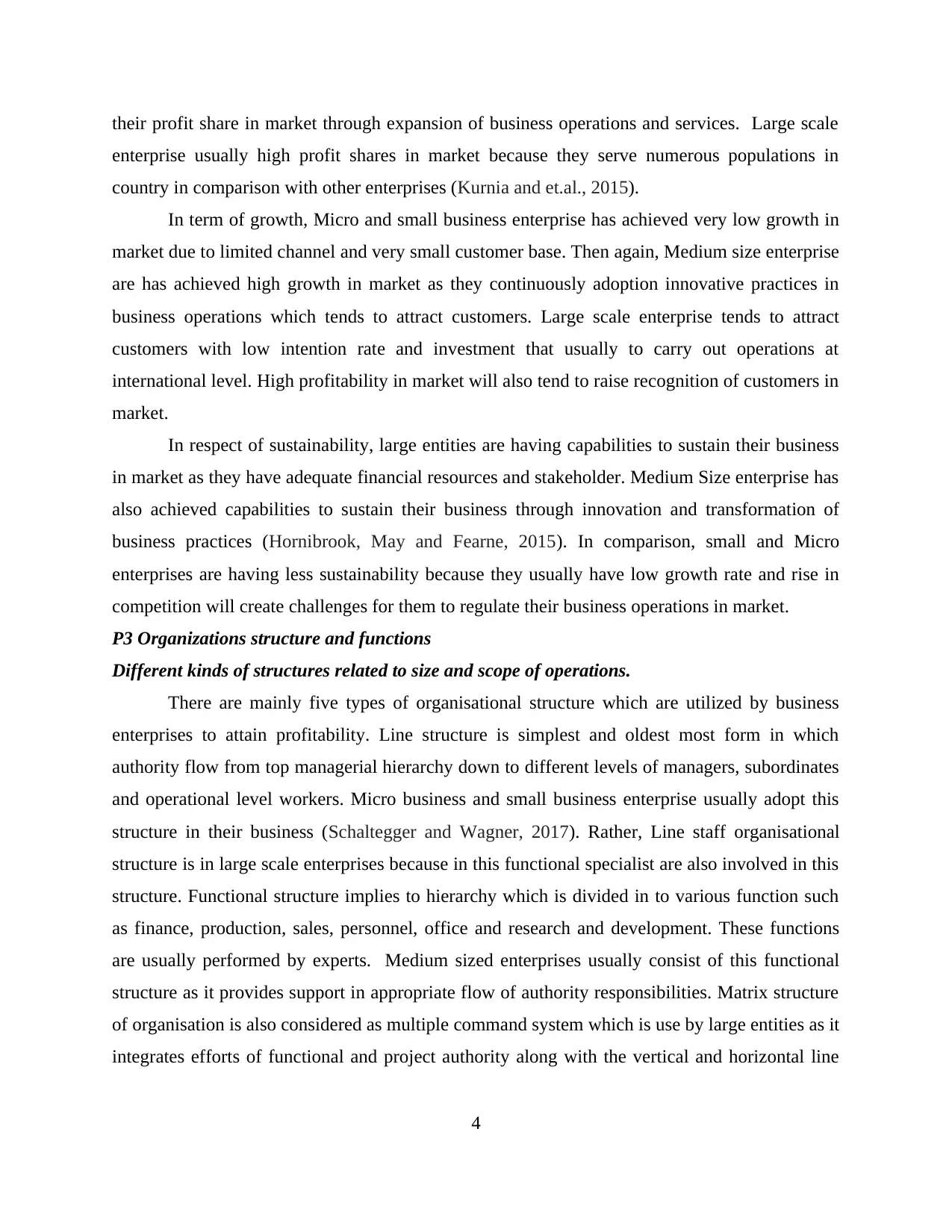
their profit share in market through expansion of business operations and services. Large scale
enterprise usually high profit shares in market because they serve numerous populations in
country in comparison with other enterprises (Kurnia and et.al., 2015).
In term of growth, Micro and small business enterprise has achieved very low growth in
market due to limited channel and very small customer base. Then again, Medium size enterprise
are has achieved high growth in market as they continuously adoption innovative practices in
business operations which tends to attract customers. Large scale enterprise tends to attract
customers with low intention rate and investment that usually to carry out operations at
international level. High profitability in market will also tend to raise recognition of customers in
market.
In respect of sustainability, large entities are having capabilities to sustain their business
in market as they have adequate financial resources and stakeholder. Medium Size enterprise has
also achieved capabilities to sustain their business through innovation and transformation of
business practices (Hornibrook, May and Fearne, 2015). In comparison, small and Micro
enterprises are having less sustainability because they usually have low growth rate and rise in
competition will create challenges for them to regulate their business operations in market.
P3 Organizations structure and functions
Different kinds of structures related to size and scope of operations.
There are mainly five types of organisational structure which are utilized by business
enterprises to attain profitability. Line structure is simplest and oldest most form in which
authority flow from top managerial hierarchy down to different levels of managers, subordinates
and operational level workers. Micro business and small business enterprise usually adopt this
structure in their business (Schaltegger and Wagner, 2017). Rather, Line staff organisational
structure is in large scale enterprises because in this functional specialist are also involved in this
structure. Functional structure implies to hierarchy which is divided in to various function such
as finance, production, sales, personnel, office and research and development. These functions
are usually performed by experts. Medium sized enterprises usually consist of this functional
structure as it provides support in appropriate flow of authority responsibilities. Matrix structure
of organisation is also considered as multiple command system which is use by large entities as it
integrates efforts of functional and project authority along with the vertical and horizontal line
4
enterprise usually high profit shares in market because they serve numerous populations in
country in comparison with other enterprises (Kurnia and et.al., 2015).
In term of growth, Micro and small business enterprise has achieved very low growth in
market due to limited channel and very small customer base. Then again, Medium size enterprise
are has achieved high growth in market as they continuously adoption innovative practices in
business operations which tends to attract customers. Large scale enterprise tends to attract
customers with low intention rate and investment that usually to carry out operations at
international level. High profitability in market will also tend to raise recognition of customers in
market.
In respect of sustainability, large entities are having capabilities to sustain their business
in market as they have adequate financial resources and stakeholder. Medium Size enterprise has
also achieved capabilities to sustain their business through innovation and transformation of
business practices (Hornibrook, May and Fearne, 2015). In comparison, small and Micro
enterprises are having less sustainability because they usually have low growth rate and rise in
competition will create challenges for them to regulate their business operations in market.
P3 Organizations structure and functions
Different kinds of structures related to size and scope of operations.
There are mainly five types of organisational structure which are utilized by business
enterprises to attain profitability. Line structure is simplest and oldest most form in which
authority flow from top managerial hierarchy down to different levels of managers, subordinates
and operational level workers. Micro business and small business enterprise usually adopt this
structure in their business (Schaltegger and Wagner, 2017). Rather, Line staff organisational
structure is in large scale enterprises because in this functional specialist are also involved in this
structure. Functional structure implies to hierarchy which is divided in to various function such
as finance, production, sales, personnel, office and research and development. These functions
are usually performed by experts. Medium sized enterprises usually consist of this functional
structure as it provides support in appropriate flow of authority responsibilities. Matrix structure
of organisation is also considered as multiple command system which is use by large entities as it
integrates efforts of functional and project authority along with the vertical and horizontal line
4
⊘ This is a preview!⊘
Do you want full access?
Subscribe today to unlock all pages.

Trusted by 1+ million students worldwide
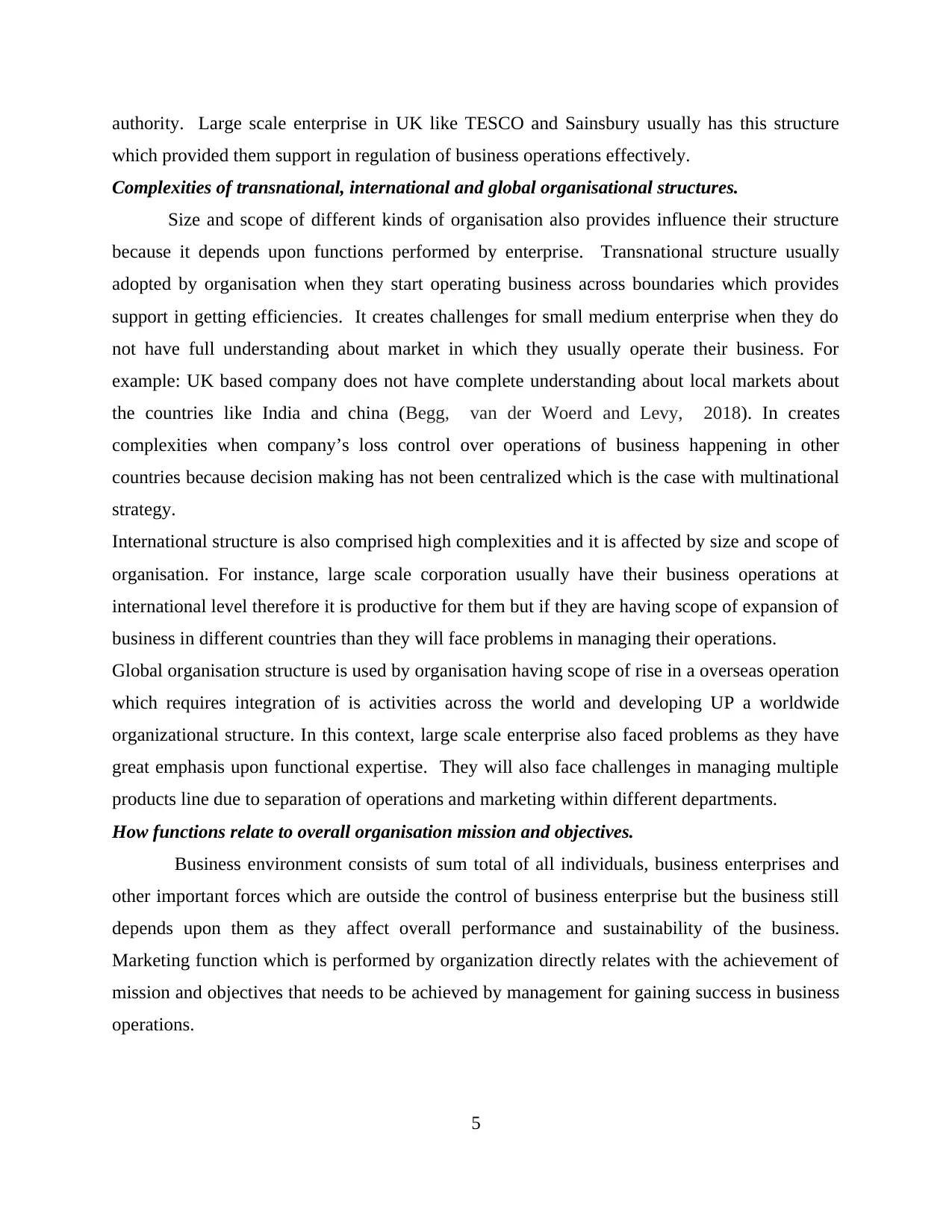
authority. Large scale enterprise in UK like TESCO and Sainsbury usually has this structure
which provided them support in regulation of business operations effectively.
Complexities of transnational, international and global organisational structures.
Size and scope of different kinds of organisation also provides influence their structure
because it depends upon functions performed by enterprise. Transnational structure usually
adopted by organisation when they start operating business across boundaries which provides
support in getting efficiencies. It creates challenges for small medium enterprise when they do
not have full understanding about market in which they usually operate their business. For
example: UK based company does not have complete understanding about local markets about
the countries like India and china (Begg, van der Woerd and Levy, 2018). In creates
complexities when company’s loss control over operations of business happening in other
countries because decision making has not been centralized which is the case with multinational
strategy.
International structure is also comprised high complexities and it is affected by size and scope of
organisation. For instance, large scale corporation usually have their business operations at
international level therefore it is productive for them but if they are having scope of expansion of
business in different countries than they will face problems in managing their operations.
Global organisation structure is used by organisation having scope of rise in a overseas operation
which requires integration of is activities across the world and developing UP a worldwide
organizational structure. In this context, large scale enterprise also faced problems as they have
great emphasis upon functional expertise. They will also face challenges in managing multiple
products line due to separation of operations and marketing within different departments.
How functions relate to overall organisation mission and objectives.
Business environment consists of sum total of all individuals, business enterprises and
other important forces which are outside the control of business enterprise but the business still
depends upon them as they affect overall performance and sustainability of the business.
Marketing function which is performed by organization directly relates with the achievement of
mission and objectives that needs to be achieved by management for gaining success in business
operations.
5
which provided them support in regulation of business operations effectively.
Complexities of transnational, international and global organisational structures.
Size and scope of different kinds of organisation also provides influence their structure
because it depends upon functions performed by enterprise. Transnational structure usually
adopted by organisation when they start operating business across boundaries which provides
support in getting efficiencies. It creates challenges for small medium enterprise when they do
not have full understanding about market in which they usually operate their business. For
example: UK based company does not have complete understanding about local markets about
the countries like India and china (Begg, van der Woerd and Levy, 2018). In creates
complexities when company’s loss control over operations of business happening in other
countries because decision making has not been centralized which is the case with multinational
strategy.
International structure is also comprised high complexities and it is affected by size and scope of
organisation. For instance, large scale corporation usually have their business operations at
international level therefore it is productive for them but if they are having scope of expansion of
business in different countries than they will face problems in managing their operations.
Global organisation structure is used by organisation having scope of rise in a overseas operation
which requires integration of is activities across the world and developing UP a worldwide
organizational structure. In this context, large scale enterprise also faced problems as they have
great emphasis upon functional expertise. They will also face challenges in managing multiple
products line due to separation of operations and marketing within different departments.
How functions relate to overall organisation mission and objectives.
Business environment consists of sum total of all individuals, business enterprises and
other important forces which are outside the control of business enterprise but the business still
depends upon them as they affect overall performance and sustainability of the business.
Marketing function which is performed by organization directly relates with the achievement of
mission and objectives that needs to be achieved by management for gaining success in business
operations.
5
Paraphrase This Document
Need a fresh take? Get an instant paraphrase of this document with our AI Paraphraser
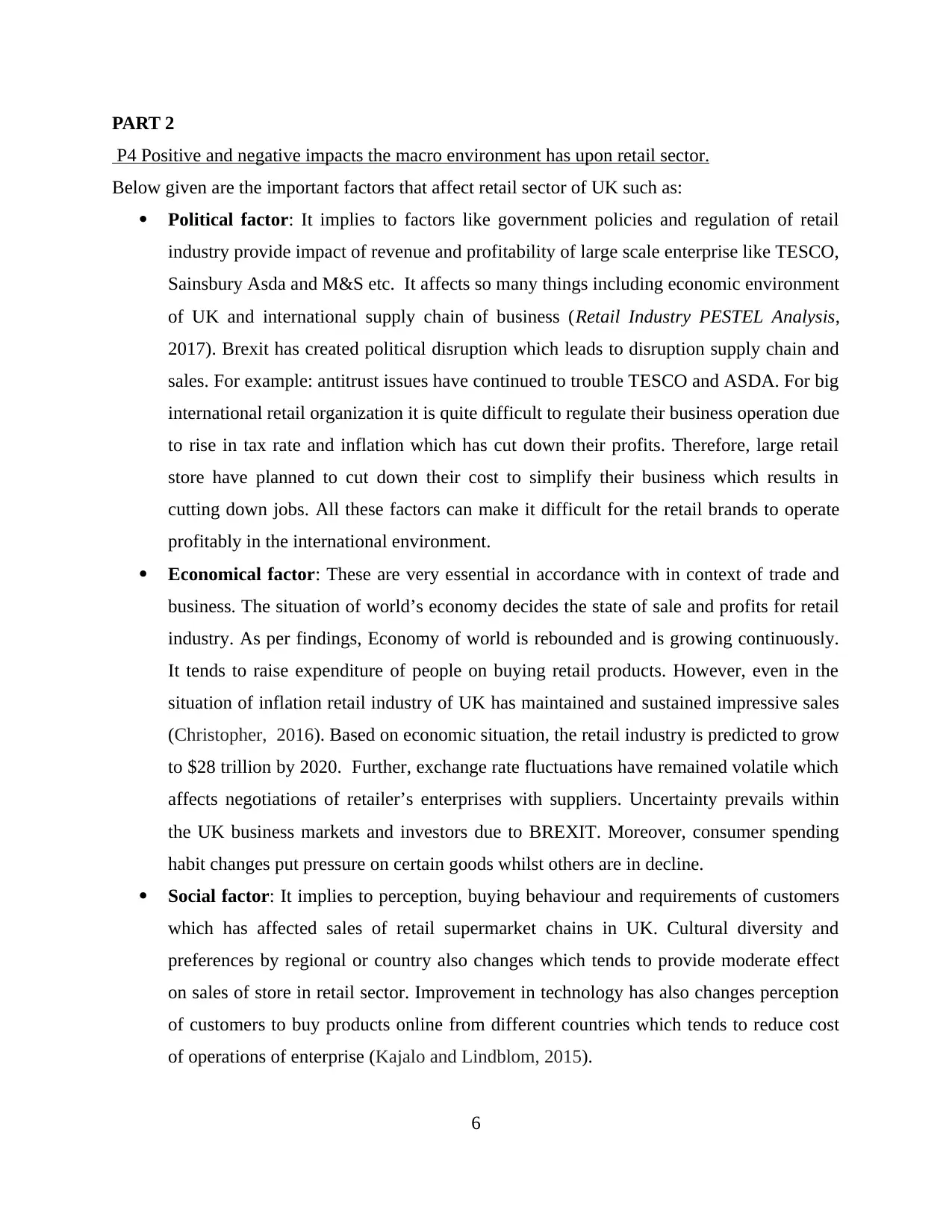
PART 2
P4 Positive and negative impacts the macro environment has upon retail sector.
Below given are the important factors that affect retail sector of UK such as:
Political factor: It implies to factors like government policies and regulation of retail
industry provide impact of revenue and profitability of large scale enterprise like TESCO,
Sainsbury Asda and M&S etc. It affects so many things including economic environment
of UK and international supply chain of business (Retail Industry PESTEL Analysis,
2017). Brexit has created political disruption which leads to disruption supply chain and
sales. For example: antitrust issues have continued to trouble TESCO and ASDA. For big
international retail organization it is quite difficult to regulate their business operation due
to rise in tax rate and inflation which has cut down their profits. Therefore, large retail
store have planned to cut down their cost to simplify their business which results in
cutting down jobs. All these factors can make it difficult for the retail brands to operate
profitably in the international environment.
Economical factor: These are very essential in accordance with in context of trade and
business. The situation of world’s economy decides the state of sale and profits for retail
industry. As per findings, Economy of world is rebounded and is growing continuously.
It tends to raise expenditure of people on buying retail products. However, even in the
situation of inflation retail industry of UK has maintained and sustained impressive sales
(Christopher, 2016). Based on economic situation, the retail industry is predicted to grow
to $28 trillion by 2020. Further, exchange rate fluctuations have remained volatile which
affects negotiations of retailer’s enterprises with suppliers. Uncertainty prevails within
the UK business markets and investors due to BREXIT. Moreover, consumer spending
habit changes put pressure on certain goods whilst others are in decline.
Social factor: It implies to perception, buying behaviour and requirements of customers
which has affected sales of retail supermarket chains in UK. Cultural diversity and
preferences by regional or country also changes which tends to provide moderate effect
on sales of store in retail sector. Improvement in technology has also changes perception
of customers to buy products online from different countries which tends to reduce cost
of operations of enterprise (Kajalo and Lindblom, 2015).
6
P4 Positive and negative impacts the macro environment has upon retail sector.
Below given are the important factors that affect retail sector of UK such as:
Political factor: It implies to factors like government policies and regulation of retail
industry provide impact of revenue and profitability of large scale enterprise like TESCO,
Sainsbury Asda and M&S etc. It affects so many things including economic environment
of UK and international supply chain of business (Retail Industry PESTEL Analysis,
2017). Brexit has created political disruption which leads to disruption supply chain and
sales. For example: antitrust issues have continued to trouble TESCO and ASDA. For big
international retail organization it is quite difficult to regulate their business operation due
to rise in tax rate and inflation which has cut down their profits. Therefore, large retail
store have planned to cut down their cost to simplify their business which results in
cutting down jobs. All these factors can make it difficult for the retail brands to operate
profitably in the international environment.
Economical factor: These are very essential in accordance with in context of trade and
business. The situation of world’s economy decides the state of sale and profits for retail
industry. As per findings, Economy of world is rebounded and is growing continuously.
It tends to raise expenditure of people on buying retail products. However, even in the
situation of inflation retail industry of UK has maintained and sustained impressive sales
(Christopher, 2016). Based on economic situation, the retail industry is predicted to grow
to $28 trillion by 2020. Further, exchange rate fluctuations have remained volatile which
affects negotiations of retailer’s enterprises with suppliers. Uncertainty prevails within
the UK business markets and investors due to BREXIT. Moreover, consumer spending
habit changes put pressure on certain goods whilst others are in decline.
Social factor: It implies to perception, buying behaviour and requirements of customers
which has affected sales of retail supermarket chains in UK. Cultural diversity and
preferences by regional or country also changes which tends to provide moderate effect
on sales of store in retail sector. Improvement in technology has also changes perception
of customers to buy products online from different countries which tends to reduce cost
of operations of enterprise (Kajalo and Lindblom, 2015).
6
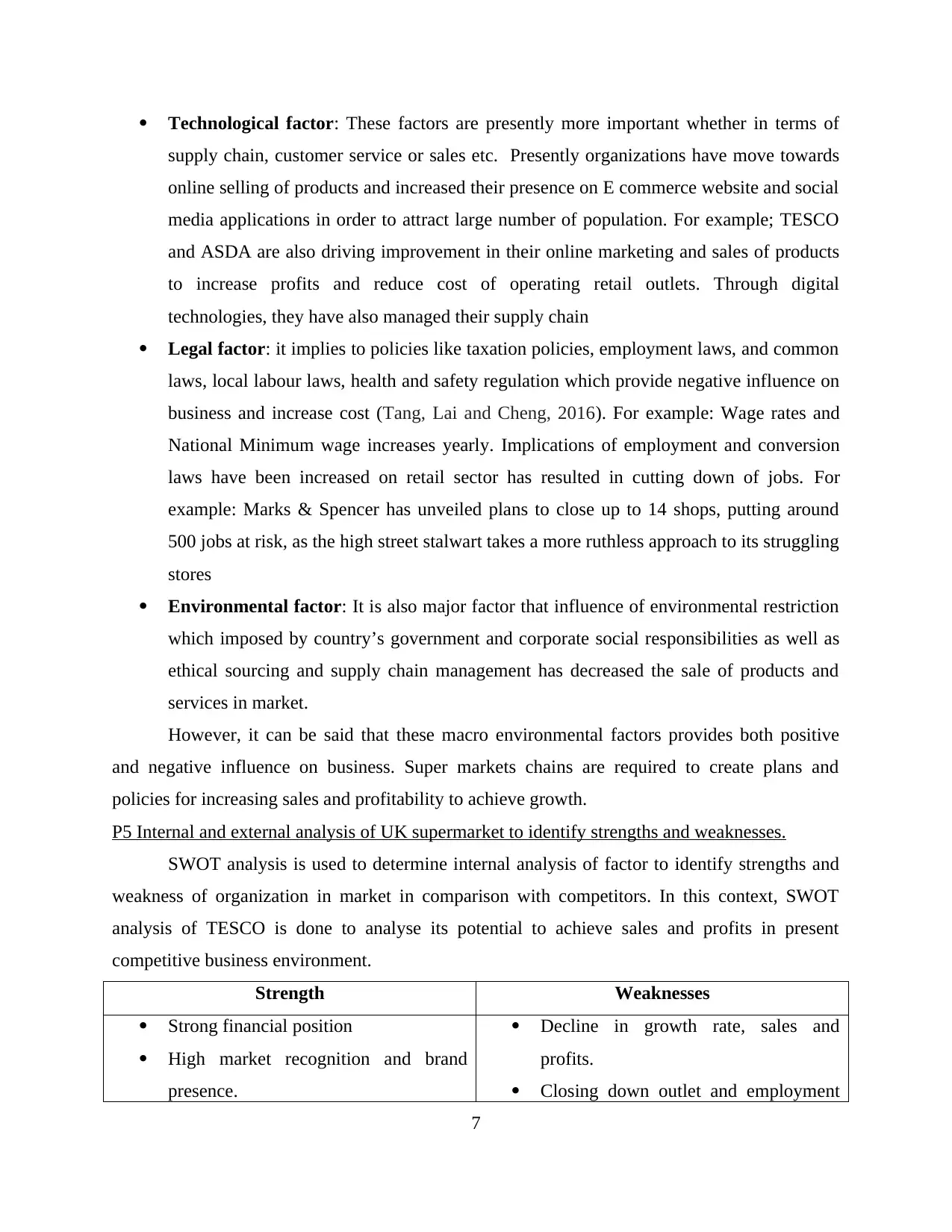
Technological factor: These factors are presently more important whether in terms of
supply chain, customer service or sales etc. Presently organizations have move towards
online selling of products and increased their presence on E commerce website and social
media applications in order to attract large number of population. For example; TESCO
and ASDA are also driving improvement in their online marketing and sales of products
to increase profits and reduce cost of operating retail outlets. Through digital
technologies, they have also managed their supply chain
Legal factor: it implies to policies like taxation policies, employment laws, and common
laws, local labour laws, health and safety regulation which provide negative influence on
business and increase cost (Tang, Lai and Cheng, 2016). For example: Wage rates and
National Minimum wage increases yearly. Implications of employment and conversion
laws have been increased on retail sector has resulted in cutting down of jobs. For
example: Marks & Spencer has unveiled plans to close up to 14 shops, putting around
500 jobs at risk, as the high street stalwart takes a more ruthless approach to its struggling
stores
Environmental factor: It is also major factor that influence of environmental restriction
which imposed by country’s government and corporate social responsibilities as well as
ethical sourcing and supply chain management has decreased the sale of products and
services in market.
However, it can be said that these macro environmental factors provides both positive
and negative influence on business. Super markets chains are required to create plans and
policies for increasing sales and profitability to achieve growth.
P5 Internal and external analysis of UK supermarket to identify strengths and weaknesses.
SWOT analysis is used to determine internal analysis of factor to identify strengths and
weakness of organization in market in comparison with competitors. In this context, SWOT
analysis of TESCO is done to analyse its potential to achieve sales and profits in present
competitive business environment.
Strength Weaknesses
Strong financial position
High market recognition and brand
presence.
Decline in growth rate, sales and
profits.
Closing down outlet and employment
7
supply chain, customer service or sales etc. Presently organizations have move towards
online selling of products and increased their presence on E commerce website and social
media applications in order to attract large number of population. For example; TESCO
and ASDA are also driving improvement in their online marketing and sales of products
to increase profits and reduce cost of operating retail outlets. Through digital
technologies, they have also managed their supply chain
Legal factor: it implies to policies like taxation policies, employment laws, and common
laws, local labour laws, health and safety regulation which provide negative influence on
business and increase cost (Tang, Lai and Cheng, 2016). For example: Wage rates and
National Minimum wage increases yearly. Implications of employment and conversion
laws have been increased on retail sector has resulted in cutting down of jobs. For
example: Marks & Spencer has unveiled plans to close up to 14 shops, putting around
500 jobs at risk, as the high street stalwart takes a more ruthless approach to its struggling
stores
Environmental factor: It is also major factor that influence of environmental restriction
which imposed by country’s government and corporate social responsibilities as well as
ethical sourcing and supply chain management has decreased the sale of products and
services in market.
However, it can be said that these macro environmental factors provides both positive
and negative influence on business. Super markets chains are required to create plans and
policies for increasing sales and profitability to achieve growth.
P5 Internal and external analysis of UK supermarket to identify strengths and weaknesses.
SWOT analysis is used to determine internal analysis of factor to identify strengths and
weakness of organization in market in comparison with competitors. In this context, SWOT
analysis of TESCO is done to analyse its potential to achieve sales and profits in present
competitive business environment.
Strength Weaknesses
Strong financial position
High market recognition and brand
presence.
Decline in growth rate, sales and
profits.
Closing down outlet and employment
7
⊘ This is a preview!⊘
Do you want full access?
Subscribe today to unlock all pages.

Trusted by 1+ million students worldwide
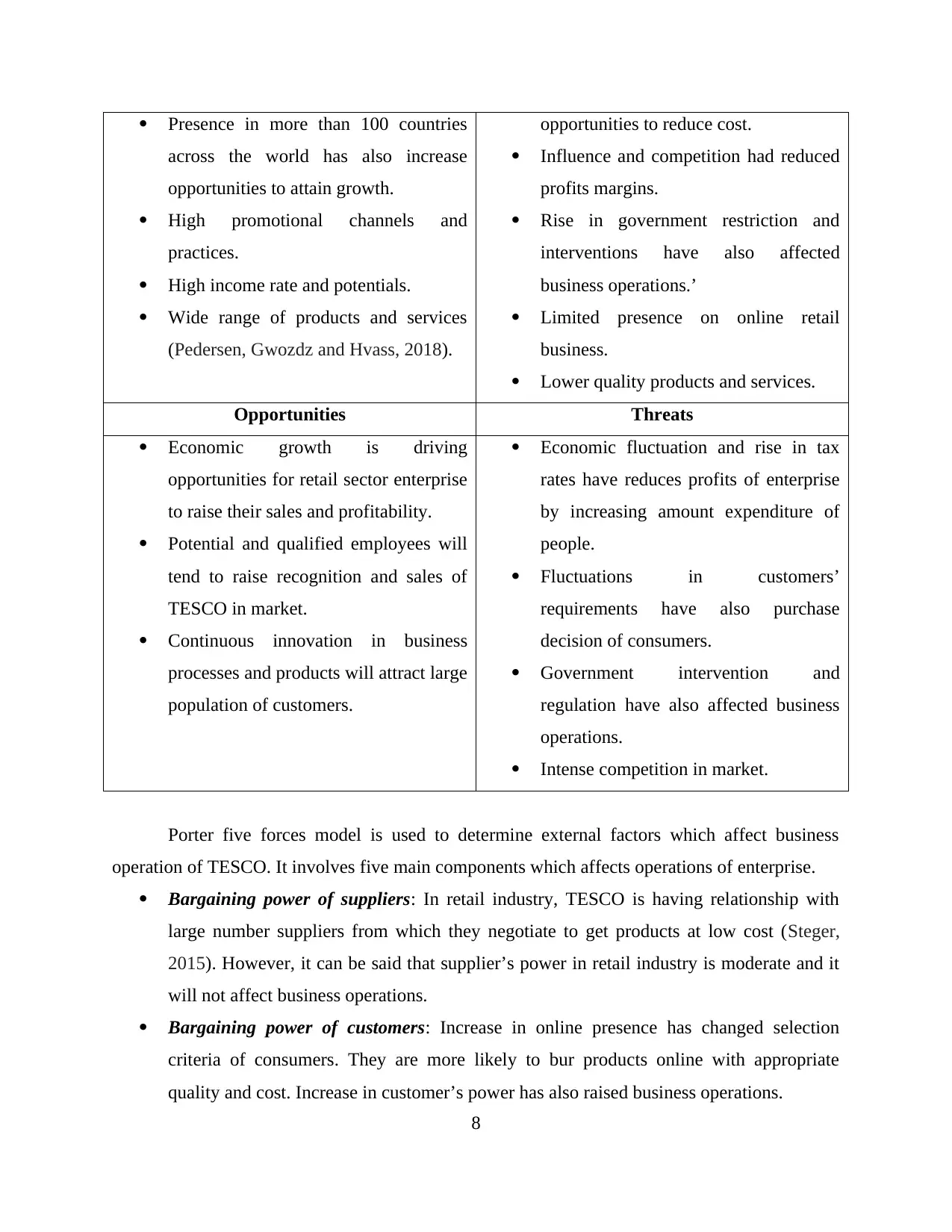
Presence in more than 100 countries
across the world has also increase
opportunities to attain growth.
High promotional channels and
practices.
High income rate and potentials.
Wide range of products and services
(Pedersen, Gwozdz and Hvass, 2018).
opportunities to reduce cost.
Influence and competition had reduced
profits margins.
Rise in government restriction and
interventions have also affected
business operations.’
Limited presence on online retail
business.
Lower quality products and services.
Opportunities Threats
Economic growth is driving
opportunities for retail sector enterprise
to raise their sales and profitability.
Potential and qualified employees will
tend to raise recognition and sales of
TESCO in market.
Continuous innovation in business
processes and products will attract large
population of customers.
Economic fluctuation and rise in tax
rates have reduces profits of enterprise
by increasing amount expenditure of
people.
Fluctuations in customers’
requirements have also purchase
decision of consumers.
Government intervention and
regulation have also affected business
operations.
Intense competition in market.
Porter five forces model is used to determine external factors which affect business
operation of TESCO. It involves five main components which affects operations of enterprise.
Bargaining power of suppliers: In retail industry, TESCO is having relationship with
large number suppliers from which they negotiate to get products at low cost (Steger,
2015). However, it can be said that supplier’s power in retail industry is moderate and it
will not affect business operations.
Bargaining power of customers: Increase in online presence has changed selection
criteria of consumers. They are more likely to bur products online with appropriate
quality and cost. Increase in customer’s power has also raised business operations.
8
across the world has also increase
opportunities to attain growth.
High promotional channels and
practices.
High income rate and potentials.
Wide range of products and services
(Pedersen, Gwozdz and Hvass, 2018).
opportunities to reduce cost.
Influence and competition had reduced
profits margins.
Rise in government restriction and
interventions have also affected
business operations.’
Limited presence on online retail
business.
Lower quality products and services.
Opportunities Threats
Economic growth is driving
opportunities for retail sector enterprise
to raise their sales and profitability.
Potential and qualified employees will
tend to raise recognition and sales of
TESCO in market.
Continuous innovation in business
processes and products will attract large
population of customers.
Economic fluctuation and rise in tax
rates have reduces profits of enterprise
by increasing amount expenditure of
people.
Fluctuations in customers’
requirements have also purchase
decision of consumers.
Government intervention and
regulation have also affected business
operations.
Intense competition in market.
Porter five forces model is used to determine external factors which affect business
operation of TESCO. It involves five main components which affects operations of enterprise.
Bargaining power of suppliers: In retail industry, TESCO is having relationship with
large number suppliers from which they negotiate to get products at low cost (Steger,
2015). However, it can be said that supplier’s power in retail industry is moderate and it
will not affect business operations.
Bargaining power of customers: Increase in online presence has changed selection
criteria of consumers. They are more likely to bur products online with appropriate
quality and cost. Increase in customer’s power has also raised business operations.
8
Paraphrase This Document
Need a fresh take? Get an instant paraphrase of this document with our AI Paraphraser
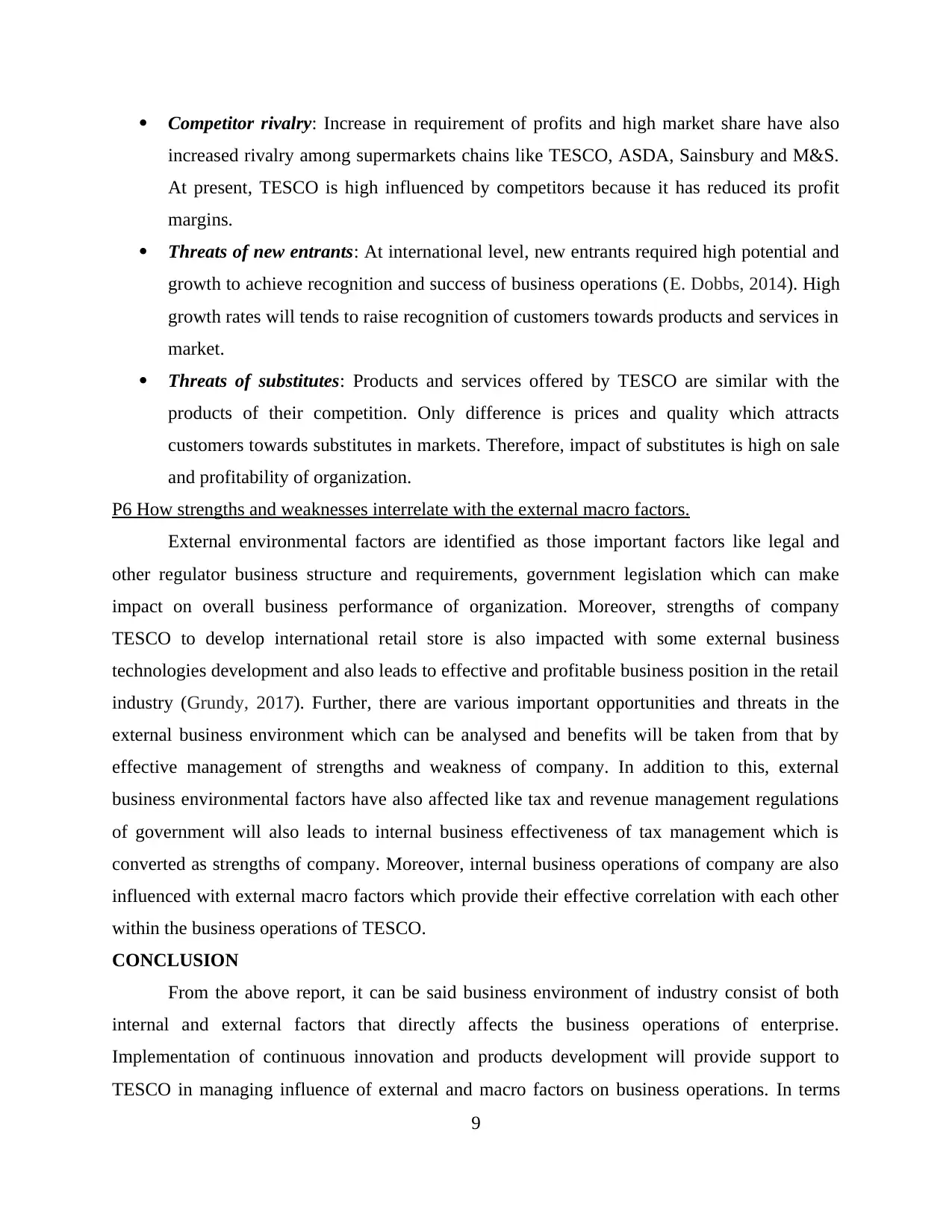
Competitor rivalry: Increase in requirement of profits and high market share have also
increased rivalry among supermarkets chains like TESCO, ASDA, Sainsbury and M&S.
At present, TESCO is high influenced by competitors because it has reduced its profit
margins.
Threats of new entrants: At international level, new entrants required high potential and
growth to achieve recognition and success of business operations (E. Dobbs, 2014). High
growth rates will tends to raise recognition of customers towards products and services in
market.
Threats of substitutes: Products and services offered by TESCO are similar with the
products of their competition. Only difference is prices and quality which attracts
customers towards substitutes in markets. Therefore, impact of substitutes is high on sale
and profitability of organization.
P6 How strengths and weaknesses interrelate with the external macro factors.
External environmental factors are identified as those important factors like legal and
other regulator business structure and requirements, government legislation which can make
impact on overall business performance of organization. Moreover, strengths of company
TESCO to develop international retail store is also impacted with some external business
technologies development and also leads to effective and profitable business position in the retail
industry (Grundy, 2017). Further, there are various important opportunities and threats in the
external business environment which can be analysed and benefits will be taken from that by
effective management of strengths and weakness of company. In addition to this, external
business environmental factors have also affected like tax and revenue management regulations
of government will also leads to internal business effectiveness of tax management which is
converted as strengths of company. Moreover, internal business operations of company are also
influenced with external macro factors which provide their effective correlation with each other
within the business operations of TESCO.
CONCLUSION
From the above report, it can be said business environment of industry consist of both
internal and external factors that directly affects the business operations of enterprise.
Implementation of continuous innovation and products development will provide support to
TESCO in managing influence of external and macro factors on business operations. In terms
9
increased rivalry among supermarkets chains like TESCO, ASDA, Sainsbury and M&S.
At present, TESCO is high influenced by competitors because it has reduced its profit
margins.
Threats of new entrants: At international level, new entrants required high potential and
growth to achieve recognition and success of business operations (E. Dobbs, 2014). High
growth rates will tends to raise recognition of customers towards products and services in
market.
Threats of substitutes: Products and services offered by TESCO are similar with the
products of their competition. Only difference is prices and quality which attracts
customers towards substitutes in markets. Therefore, impact of substitutes is high on sale
and profitability of organization.
P6 How strengths and weaknesses interrelate with the external macro factors.
External environmental factors are identified as those important factors like legal and
other regulator business structure and requirements, government legislation which can make
impact on overall business performance of organization. Moreover, strengths of company
TESCO to develop international retail store is also impacted with some external business
technologies development and also leads to effective and profitable business position in the retail
industry (Grundy, 2017). Further, there are various important opportunities and threats in the
external business environment which can be analysed and benefits will be taken from that by
effective management of strengths and weakness of company. In addition to this, external
business environmental factors have also affected like tax and revenue management regulations
of government will also leads to internal business effectiveness of tax management which is
converted as strengths of company. Moreover, internal business operations of company are also
influenced with external macro factors which provide their effective correlation with each other
within the business operations of TESCO.
CONCLUSION
From the above report, it can be said business environment of industry consist of both
internal and external factors that directly affects the business operations of enterprise.
Implementation of continuous innovation and products development will provide support to
TESCO in managing influence of external and macro factors on business operations. In terms
9
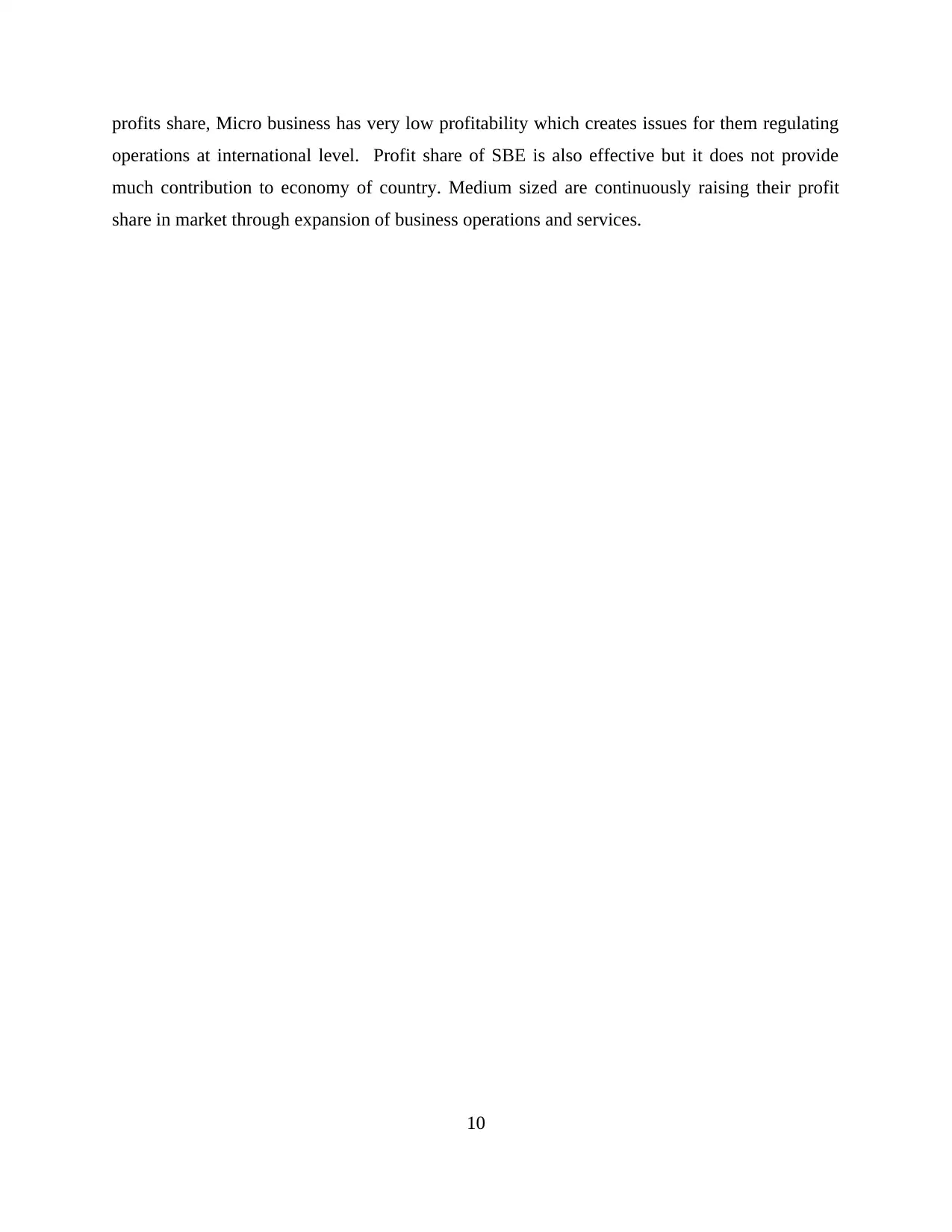
profits share, Micro business has very low profitability which creates issues for them regulating
operations at international level. Profit share of SBE is also effective but it does not provide
much contribution to economy of country. Medium sized are continuously raising their profit
share in market through expansion of business operations and services.
10
operations at international level. Profit share of SBE is also effective but it does not provide
much contribution to economy of country. Medium sized are continuously raising their profit
share in market through expansion of business operations and services.
10
⊘ This is a preview!⊘
Do you want full access?
Subscribe today to unlock all pages.

Trusted by 1+ million students worldwide
1 out of 14
Related Documents
Your All-in-One AI-Powered Toolkit for Academic Success.
+13062052269
info@desklib.com
Available 24*7 on WhatsApp / Email
![[object Object]](/_next/static/media/star-bottom.7253800d.svg)
Unlock your academic potential
Copyright © 2020–2025 A2Z Services. All Rights Reserved. Developed and managed by ZUCOL.





